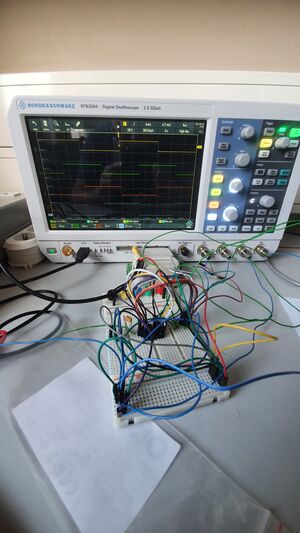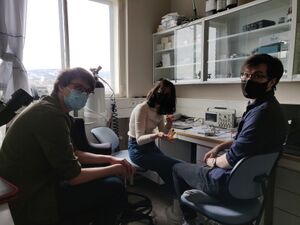Rotating cells
This is the main page of the rotating cells/electrorotation project.
Contents
Protocols
Time line
-16.03.21 First online meeting within the electrorotation group, in which we introduced each other and talked about our backgrounds and research interests.
-24.03.21 Online seminar about electrorotation and ponderomotive forces in general given by Prof. Jan Gimsa from the University of Rostock.
-29.03.21 Second online meeting within the electrorotation group before Easter break where we discussed our plan of action. First thing on the to-do list is to develop instrumentation that enables electrorotation.
-08.04.21 Some members of the team got started on develop the instrumentation. The prototype has been developed and checked on a breadboard. The results were not perfect and needs more work.
-13.04.21/14.04.21 Third online meeting within the electrorotation group. The team has decided to test out the instrumentation for electrorotation using yeast cells in order to see whether we will be able to rotate the cells. Team members have also discussed potential project ideas, where some consisted of working with cancer cells, specifically on tumour heterogeneity or researching their polarity, which would be possible to do using electrorotation. Some other ideas consisted of looking into a genetic illness called ALD, which stands for Adrenoleukodystrophy. In order to decide on the research title, the team has decided to have a meeting with a few experts in the nearby future to discuss the feasibility of these ideas.
The prototype has also been fixed - the device is now able to produce a signal with correct phase shifts using a D flip flop.
----- Summer Break -----
-13.10.21 Electrorotation team had its first official meeting with the new and old members of the group. We have discussed the future of our project, particularly our ideas regarding ADL and inspecting it using electrorotation. The biologists of the group drafted a research proposal that we will be making come to life. To do so, we agreed on drafting an email to the Hybrid Technology Hub (HTH) to get help with the cell lines and other biological methods that we will need in order to "induce" ALD in our cells.
-26.10.21 Meeting with a post.doc from HTL to discuss cell lines. Exchanged ideas, as well as past research papers with focus on ALD. Potentially getting cell lines from another research group, however, this is of sensitive matter and should be done within the framework of an MTA allowing them to be associated with our work on these cells. Hence, we will be joining future publications, which our group is very excited about.
----- Christmas Break -----
-15.03.22 Meeting with Prof. Jan Gimsa about various problems we have had with our chip and rotation experiments, particularly the foramtion of bubbles which has made observing the cell difficult. We recived alot of insight on possible solutions to our ongoing problems, as well Jan pointed out to us that the chip seems damaged and informed us on what we should consider in the aquasition of a new chip. We also discussed a possible jurney to the University of Rostock by some of the members of the group.
- 05.05.22 During a rotation experiement with Hela cells, we observed the formation of crystals in the rotation chamber after a short time of use. As this could pose a major problem for further experiments, we decided to have meeting to discuss possible reasons behind crystalization and the degredation of our electrodes.
- 10.05.22 Meeting of the electrorotation group to discuss the production of new electrode chips and the formation of crystals in the rotation chamber. We decided to do an experiments to find the primary reason for the crystalization from the various hypothesis discussed. The team was infomed that we have recived new electrodes from Prof. Jan Gimsa. Upon discussing the problem involved in manufacturing new chips it was decided that we should take a week to review the avalible material on this subject to better informe the process.
-18.05.22 Meeting of the electrorotation group with Prof. Dag Kristian Dysthe to look for solutions and reasons for the crystalization occuring on our rotation chip
Project progression
First semester: 03.21 - 06.21 :
- We need to start to develop the instrumentation that enables electrorotation. We got already the electrodes for it (see Fig. 1) and just need to add some small electrical circuit that enables the application of an alternating electrical field.
-The development of the instrumentation has been started. Members of the team followed Anders Jansen's master thesis section Method and materials, specifically Figure 3.6, in order to connect the dual D-type Flip Flop. The D flip flop used by us was different to the one used by Anders, so we had to follow the data sheet of our d flip flop in order to install it correctly, while still following Jansen's circuit diagram. D flip flop used by us was Toshiba TC74HC74AP.
Second semester: 08.21 - 12.21 :
- Working on acquiring cell lines from HTH in collaboration with external research groups in the framework of MTA. Introducing new members to our work and research project.
- Getting some training with the new cells lines to get experience with cell culturing and keeping cells alive. Then, rotating the cells and obtaining rotational spectra.
Third semester: 01.22 - 06.22 :
- experimenting electrorotation on HeLa cells before moving onto more advanced mice cell lines
Fourth semester: 08.22 - 12.22
- getting HeLa cells to rotate by adjusting the rotation medium
- perfecting the rotation protocol
Experiments
Lab notes and semester updates
Literature - inspiration for the project
- Jan Gimsa "A Unified Resistor-Capacitor Model for Impedance, Dielectrophoresis, Electrorotation, and Induced Transmembrane Potential"
https://doi.org/10.1016/S0006-3495(98)77600-3
- Ørjan G. Martinsen et al. "Interface phenomena and dielectric properties of biological tissue"
https://www.mn.uio.no/fysikk/english/research/projects/bioimpedance/publications/papers/encyclop.pdf
- Master thesis Anders Jansen " A feasibility study of electrorotation as an alternative to impedance measurements"
https://www.duo.uio.no/bitstream/handle/10852/65672/1/Masteroppgave---Anders-Jansen.pdf
Literature - by students
Click on the title to read more about the theory behind what we do, and motivation for the current project.


